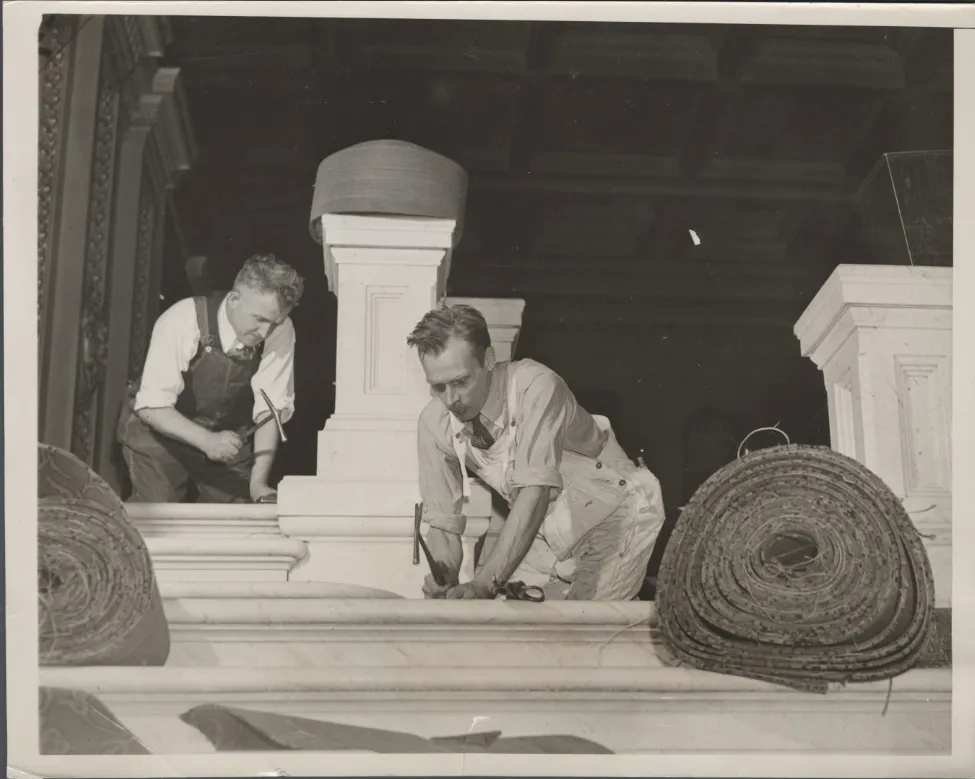A Brief History of Congressional Carpets
There’s more to the House floor than meets the eye
/https://tf-cmsv2-smithsonianmag-media.s3.amazonaws.com/filer/c1/86/c18647cb-492c-4087-8b29-849814421cb2/screen_shot_2016-06-23_at_102328_am.png)
If you tune into C-SPAN during the course of ordinary House business, you’ll see a collection of representatives doing their thing in a grand chamber designed with legislation in mind. But during the House Democrats’ sit-in for gun rights legislation, you might have seen something different—respected members of Congress sitting on the House Chamber’s equally grand carpet. And it turns out that beneath that fancy furnishing lies a maintenance operation that’s almost as complex and consequential as the business of lawmaking itself.
You’d think that the Chamber’s royal blue carpets festooned with golden wreaths and red and gold accents are overseen by the Architect of the Capitol, who is responsible for running and preserving the 17.4 million square feet of buildings and government land associated with Capitol Hill in Washington, D.C. The office of the AOC has around 2,300 employees and includes everyone from historical preservationists to masons, electricians and mechanics. But the maintenance of the gorgeous House facilities falls to the similarly acronymed Office of the Chief Administrative Officer (CAO), which oversees all administrative functions for the House of Representatives.

It takes a huge brigade of carpet cleaners and maintainers to make sure that the floors of the House are fit for the activities that happen within, and carpets are regularly renovated and restored throughout the complex. To put it in context, in 2014 the CAO received 1,677 maintenance requests and paid nearly 70,000 invoices to vendors. That’s a lot of carpet (and vacuum bags, and brooms, and cleaning supplies).
The House hasn’t always had brightly patterned carpet. Past remodels, for example, featured sedate and plain carpet. But changing times—and technologies—have affected the carpets, too. In 1999, Stacy Zolt reported for an archival Roll Call story that the wiring beneath the House floor would be updated for modern times, and that era’s iteration of the carpet (blue-patterned by that point) was updated to a brighter, more TV-friendly color. In 2013, the CAO took over the massive work of cleaning the Capitol’s carpets itself—to the tune of a $200,000 annual savings. And in 2014, the House floor was given a brand-new carpet that was installed by Logistics and Support staff over the Easter recess. (Want a look? Click here for a virtual tour of the Chamber.)
Carpet may seem dull, but its history turns out to be anything but. In fact, how Congress treats its carpets can tell you something about the political climate that’s afoot. The perfect (if somewhat repulsive) example is the popularity of chewing tobacco among Congress members through the turn of the 20th century. Spittoons were available all over the House, often serving as weapons but also providing plenty of opportunities to aim at—and miss—the spit receptacle.
As the House of Representatives blog recalls, the condition of the carpets became so gross as a result that Charles Dickens called the House “the headquarters of tobacco-tinctured saliva”…and an 1895 report on the sanitary conditions of the Capitol complained about the spittoons that “would not be tolerated in the barroom of a mining camp.” The report also characterized ventilation on the House floor as “the straining of air through shafts coated with carpet lint, and charged with the vilest of vile matter from the throats and lungs of over 400 people”, a condition the author, George Washington Shell, said posed a real problem. As he noted, "the danger to the life of those who breathe that air can not be overestimated".
Of course, the action inside the House Chamber is usually about more than decor. But the floor is the place where the drama unfolds, as when Republicans staged a 2008 sit-in over energy legislation. In 1858, more than 30 Representatives rushed the floor in what can only be categorized as a brawl—a melee that erupted over slavery in the Kansas Territory and that involved both the House mace (the silver symbol of the House’s authority) and torn-off hairpieces. Though all eyes are normally on those standing—or sitting—on the House floor, it's worth taking a moment to appreciate the carpet that cushions the politics.
/https://tf-cmsv2-smithsonianmag-media.s3.amazonaws.com/accounts/headshot/erin.png)
/https://tf-cmsv2-smithsonianmag-media.s3.amazonaws.com/accounts/headshot/erin.png)